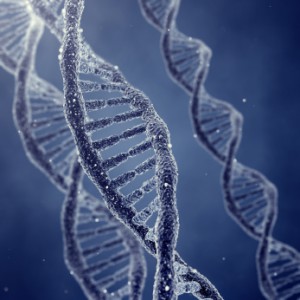
Diamond™ Nucleic Acid Dye (Cat# H1181) is a safe, inexpensive and sensitive fluorescent dye option that binds to single-stranded and double-stranded DNA and RNA. Diamond™ Dye typically is used for staining electrophoresis gels to visualize nucleic acids in a similar to its carcinogenic counterpart, ethidium bromide. However Diamond™ Dye has several advantages: gels stained with Diamond™ Dye can be visualized using either UV or blue-light transilluminators. Also, a wash step after staining is not necessary when using Diamond™ Dye, unlike what is typically recommended for ethidium bromide.
Besides staining electrophoresis gels, there are other applications for this diamond in the rough. Highlighted below are two fascinating uses of this multifaceted tool: touch DNA localization and qPCR detection.
Touch DNA localization. Touch DNA is DNA from epithelial cells that are left behind after we touch something, typically within a fingerprint, or a lip print. This touch DNA can then be amplified and evaluated for short tandem repeats, or STRs, which can help identify or clear a suspect. During investigation of a crime scene, it can be difficult to determine exactly where to look for touch DNA. Tonkrongjun et al. studied the use of fluorescent nucleic acid dyes to detect areas containing touch DNA. They determined that when the fluorescent dyes, including Diamond™ dye, are sprayed onto items, the touch DNA fluoresces. This allows faster and easier fingerprint detection and collection for further analysis, including direct PCR for STR amplification. Read the full journal article here.
Detection dye in qPCR. The most commonly used fluorescent dye for qPCR is SYBR Green. However, SYBR Green has low fluorescence and can inhibit PCR at high concentrations. SYBR Green is also highly mutagenic. Haines et al. evaluated and optimized Diamond™ Dye for use in qPCR and high-resolution melt (HRM) curve analysis. They found that Diamond™ Dye is a suitable alternative to the most common fluorescent dyes available today. As a bonus, Diamond™ Dye is costs less! Read the full journal article here.
Literature Cited
Kipipit, T. et al. (2017) Touch DNA localization and direct PCR: An improved workflow for STR typing from improvise explosive devices. Forensic Science International: Genetics Supplement Series 6, e610–e612.
Linacre, A., Tobe, S.S. and Haines, A. M. (2018) Optimization of Diamond Nucleic Acid Dye for Quantitative PCR Biotechniques 61, 183–189.
Related Posts
Latest posts by Leah Cronan (see all)
- Mass Spec for Glycosylation Analysis of SARS-CoV-2 Proteins Implicated in Host-Cell Entry - November 10, 2020
- Proteomics from a Different Point of View: Introducing ProAlanase, the Newest Mass-Spec Grade Protease from Promega - August 7, 2020
- Go fISH! Using in situ Hybridization to Search for Expression of a SARS-CoV-2 Viral Entry Protein - July 10, 2020

One thoughtful comment